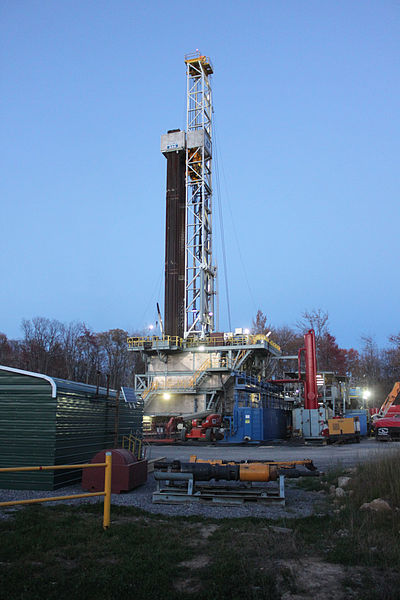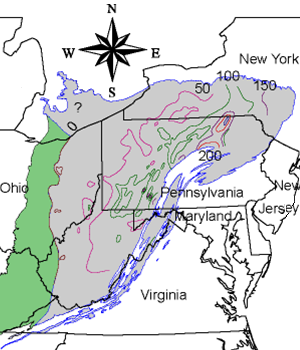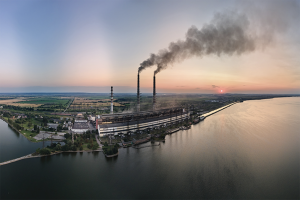
Marcellus shale drilling rig in Roulette, PA (click to enlarge)
The latest debate over Marcellus shale gas isn't about
hydraulic fracturing, or fracking, but over how much gas there is to be removed. The
U.S. Geological Survey (USGS) recently published its
estimate of how much gas is trapped in Marcellus shale and can be extracted with current technology, but the figures differ dramatically from past estimates.
Technology Review reports that the USGS's estimated volume for the shale deposit is 84 trillion cubic feet (TCF), a figure which is approximately 80 percent lower than the estimate released earlier this year by the
Energy Information Administration, an agency of the
U.S. Department of Energy.
Question of how much gas dependent on technology
The shale formation in question lies beneath portions of New York, Pennsylvania, Ohio, and West Virginia, and may be the largest deposit of
shale gas in the United States. But the question of exactly how much gas lies there is a continuing debate. The new USGS figure is the latest figure in a history of dramatically differing estimates. The previous USGS estimate from 2002 was set at only 2 TCF, but improvements in fracturing and drilling technology as well as 3D seismic imaging were in part responsible for the increase in figures.
Whatever the figure, deposit is highly significant
Other sources have estimated the recoverable gas deposits to be as significant as 489 TCF. Regardless of how much gas is actually available, Francis O'Sullivan, an engineer at the
MIT Energy Initiative who analyzed supply issues for a study of the future of natural gas released by the initiative in June, told Technology review that regardless of which figure is correct, there is a very sizable amount of recoverable gas in the shale formation. O'Sullivan estimates:
[...the Marcellus formation] could, at its peak, contribute 10 to 15 percent of the gas produced in the U.S. "What that means is that whether or not you have 200 TCF, 400 TCF, or 80 TCF of recoverable resources is quite moot at this point, and will be moot for 20 years."

Marcellus Shale Deposit. Click to enlarge.
Not volume, but safety--a challenge for chemical engineers
Commenting on the evolution of technology that will continue to increase how much gas is actually recoverable, O'Sullivan also noted in the interview, "The 20-year time horizon is a very long time in the context of technology in the gas space, and in the context of broader energy technology."
While the debate on fracking may continue, there is little debate that there is a significant deposit of natural gas that could be incredibly important to the country's future. It will be up to chemical engineers and others to find new ways to capture the gas through environmentally sound practices.
If you didn't see the amusing but informative
music video about fracking and the environment featured on ChEnected earlier this year, check it out
here.
 Marcellus shale drilling rig in Roulette, PA (click to enlarge)
The latest debate over Marcellus shale gas isn't about hydraulic fracturing, or fracking, but over how much gas there is to be removed. The U.S. Geological Survey (USGS) recently published its estimate of how much gas is trapped in Marcellus shale and can be extracted with current technology, but the figures differ dramatically from past estimates. Technology Review reports that the USGS's estimated volume for the shale deposit is 84 trillion cubic feet (TCF), a figure which is approximately 80 percent lower than the estimate released earlier this year by the Energy Information Administration, an agency of the U.S. Department of Energy.
Marcellus shale drilling rig in Roulette, PA (click to enlarge)
The latest debate over Marcellus shale gas isn't about hydraulic fracturing, or fracking, but over how much gas there is to be removed. The U.S. Geological Survey (USGS) recently published its estimate of how much gas is trapped in Marcellus shale and can be extracted with current technology, but the figures differ dramatically from past estimates. Technology Review reports that the USGS's estimated volume for the shale deposit is 84 trillion cubic feet (TCF), a figure which is approximately 80 percent lower than the estimate released earlier this year by the Energy Information Administration, an agency of the U.S. Department of Energy.
 Marcellus Shale Deposit. Click to enlarge.
Marcellus Shale Deposit. Click to enlarge.





